Paper Coater
Paper coater is a kind of paper coating machine. AGICO can helps you get to know more information about paper coater. We hope that we can give you a hand in paper making industry.
As we know, after calendering, paper fibers are no longer arranged loosely, but have a certain degree of tightness. However, the smoothness of their surfaces still cannot meet the requirements of high-grade fine printing. Uncoated paper has poor surface uniformity, uneven ink color after printing and low gloss. So it cannot restore fine dots, resulting in loss of gradation, which affects the printing reproduction effect. The surface coating processing is needed to carried out to further improve paper surface properties.
The purpose of the paper coating process is to cover the surface of the ordinary paper made of fibers with unevenness and large pores, and cover it with a coating composed of fine particles that has good absorbency to the ink in order to obtain a good uniform and smoothness of paper. Coating can also improve the gloss, stability and opacity of the paper, and these characteristics increase with the increase in the coating process.
Coated paper can be generally divided into two categories: ordinary coated paper and special coated paper. Ordinary coated paper uses ordinary coating method to apply the coating on the surface of the base paper. After drying, it is calendered, and finally cut or rolled into flat paper or roll paper, such as coated paper, matte paper and light coated paper. Special coated paper refers to printing coated paper made with special coatings or special processing methods, such as cast coated paper (glass cardboard), embossed paper, and matte coated paper. The production process of printing coated paper is as follows: Selection of base paper →coating preparation→coating→drying→calendering or surface finishing → slitting or rewinding.
After the coating is applied to the surface of the base paper, it cannot be dried directly with a dryer like non-coated paper. Because the coating is still wet, direct contact with drying will cause the coating to stick to the surface of the dryer. Generally it uses infrared drying or hot air drying, or uses these drying methods to dry to a certain degree of dryness, and then contact drying with a dryer.
The coating used for coated paper must have good coating adaptability and printability. Coating adaptability means that coating can be performed well and a uniform and smooth coating layer can be formed. In order to meet this requirement, various ingredients in the coating must be dispersed sufficiently and uniformly, and the concentration, viscosity and fluidity of the coating must be compatible with the form of the coating machine. Only good printability can show good printing results. After the coating is combined with the base paper, the surface strength required for printing must be achieved without causing powder loss during printing. It has good ink acceptability and enables the ink to be transferred evenly to the coating surface. It has good smoothness and is easy to use on super calenders. The coating layer is slightly stretched to improve the smoothness significantly; it has a high whiteness and can exhibit high gloss; high opacity can hide or make up for the defects of the original paper in terms of optical properties. In addition, different grades of coated paper require different coatings. The higher the grade is, the higher the requirements are.


Coating machine
The coater consists of a paper ejector, a coater, a dryer and paper winder. The coating operation is divided into internal type and external type according to the relationship between the coating machine and the paper making machine. And the coater can be also divided into single-layer coating and double-layer coating according to the coating times. The internal coating is equipped with a coater on the paper making machine. The machine can make paper making and coating be carried out continuously. The double-layer coated paper has better printability than the single-layer coated paper and can improve the quality of coated paper. There are three main types of the coating machines used for coating operations: roll coater, air blade coater, and blade coater.
Nowadays the maximum speed of the coating machine outside the machine has exceeded 2000m/min, and the speed of the external coating machine has reached nearly 2000m/min. The width of the coated paper web is 10m. Various coating machines have their specific application scopes. Appropriate selection and design must be based on product quality requirements.
- At present, the popular types of roll coaters internationally include door roll coater and film press coater. As a door roll coater, the coating quality is basically similar. The common characteristic is that there are two kinds of instability when the film is separated. In particular, there is a problem that the so-called orange peel is liable to occur when the coating amount is increased to a certain degree. Although the quality of roll coater is not as good as that of blade coater, it can meet the requirements of color offset printing, and produce lightweight and good-quality lightweight paper, especially its metering device does not directly contact the paper, and the strength of base paper is relatively reduced. It is more suitable for producing light coated paper with grass pulp as main raw material.
- The air blade coater is a conformal coater. It means that the coating layer only adheres to the surface and does not improve the flatness of base paper. The main components include the feeding metering system, air blade, air supply system, exhausting and recovery system, circulation system, etc.
- Blade coater is different from air blade coater. The blade inserts the coating into the pits on the paper surface and scrapes off the excess coating. For this purpose, advanced metering rods or blade can be used for coating. After the paper is flattened, the air blade is used for surface coating. The blade coater has the concerns of high-speed coating and high quality. So far it is still main coater for producing various coated printing papers. The blade coater can exert its strengths effectively only under the best coating conditions (including both base paper and coating). In order to meet the requirements for resource efficiency and production costs, it is necessary to further develop and improve the existing blade coater.
As a leading paper making equipment manufacturer, AGICO can provide you with high quality paper coating machine and relevant information about paper coater in details.

